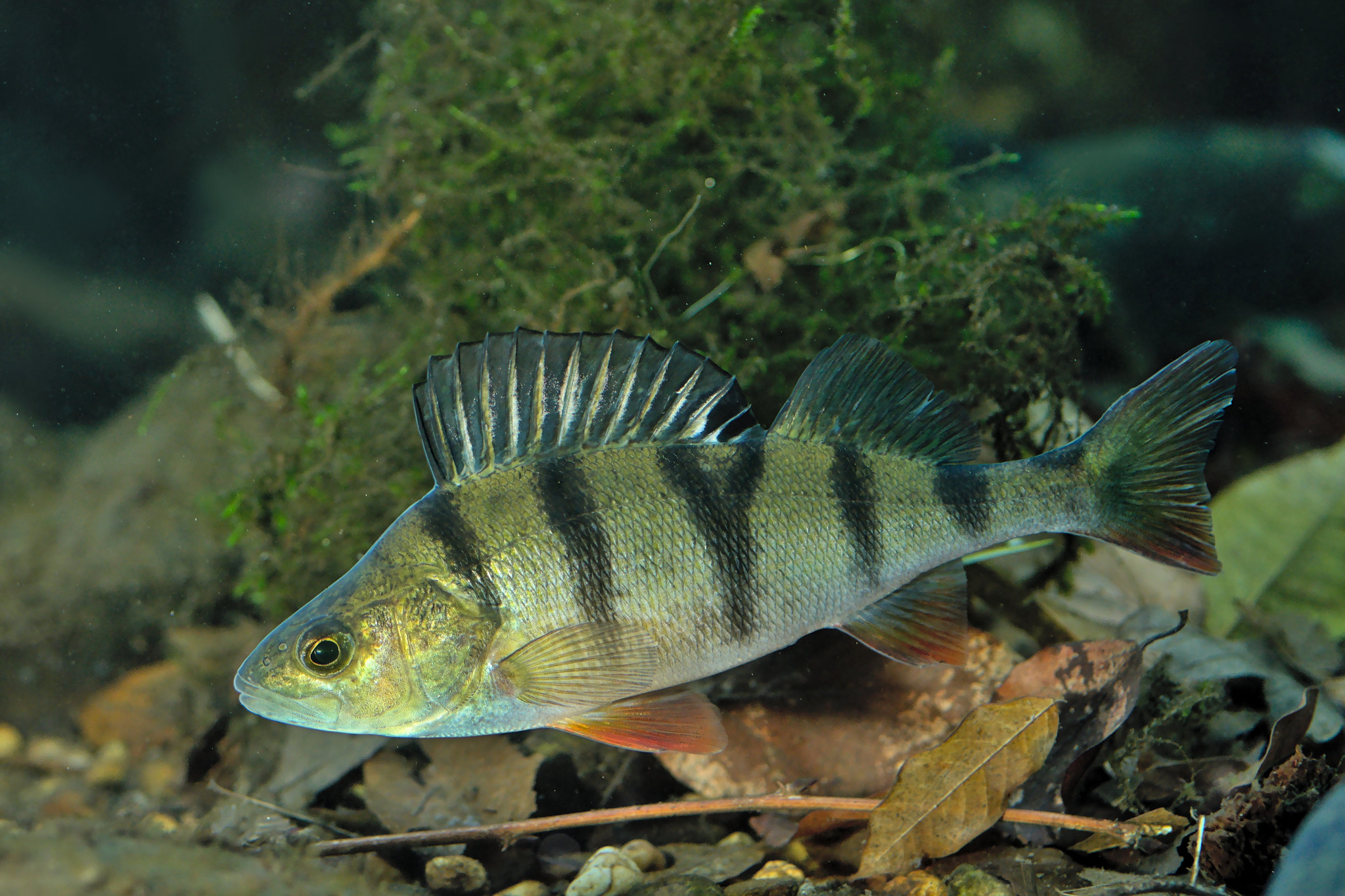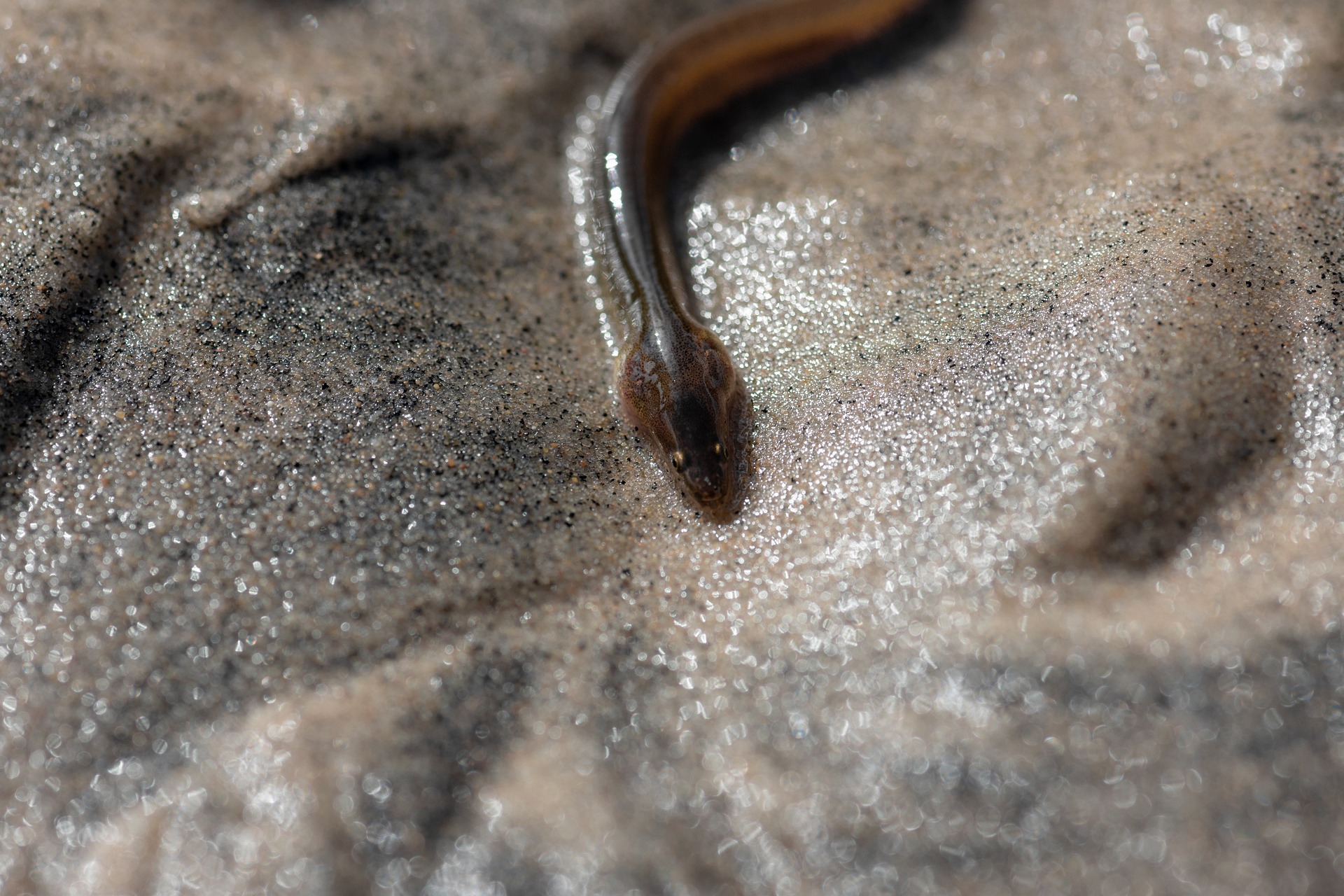Bright Side of the Night – 2.2.5
Fishes
There are nocturnal and diurnal fish species. Many, however, are particularly active at dusk and dawn. At night, predatory fish such as zander, eel and pike are often on the move. For fishes, some life processes are light-dependent, including hatching for instance.
European Perch
The European perch (Perca fluviatilis) is distributed throughout Europe, mostly Central and Northern Europe. This species adapts easily to different habitats, such as rivers or lakes, and prefers to hunt at dusk. Perch adults spawn between March and June via so-called “spawning tubes”.
European Eel
The European eel (Anguilla anguilla) is an extraordinary and unfortunately endangered crepuscular and nocturnal fish. Eel have an outstanding sense of smell and also a sense of magnetism. They are found in parts of Europe, Asia Minor and North Africa. They spawn, hatch, and die in the Sargasso Sea in the Atlantic Ocean, near the Bahamas. From there, the larvae take about three years to reach Europe’s coasts. In spring, young eel can sometimes be seen moving in large shoals from the coast upstream into the inland waters of the continent. There, they grow to full size. Females reach sexual maturity when they are 12 to 15 years old. To spawn, eel migrate from the inland waters via the rivers back to where they hatched. Eel have been observed covering distances of over 5,000 kilometres against the Gulf Stream for a whole year, and without feeding. They can also travel considerable distances over wet land because they can absorb the vital oxygen through their skin. Eels can reach an age of 50 to 80 years, in individual cases even well over 100 years, especially if they have no possibility to migrate.

Further Resources
Links below will redirect you to external websites. In accordance with the European data protection declarations, we would like to point out that by clicking on these links you may send data to external providers. We cannot prevent that.
Images
![]() A vast number of photos of fishes can be accessed at Pixabay
A vast number of photos of fishes can be accessed at Pixabay
Videos
![]() Zoological Society of London: The A mazing Life Cycle of the European Eel
Zoological Society of London: The A mazing Life Cycle of the European Eel
![]() Light pollution and its impact on the ocean
Light pollution and its impact on the ocean
Online Resources
![]()
 The influence of light pollution on plants, animals and ecosystems (Helle Not)
The influence of light pollution on plants, animals and ecosystems (Helle Not)
![]()
 What happens at night just beyond our doorstep? Bothersome-Brightness-Cartoons. (Helle Not)
What happens at night just beyond our doorstep? Bothersome-Brightness-Cartoons. (Helle Not)
![]()
 Verlust der Nacht / Loss of the Night: Interdisciplinary Research network
Verlust der Nacht / Loss of the Night: Interdisciplinary Research network
![]() Into the Night in the Kaunertal Valley (Online publication)
Into the Night in the Kaunertal Valley (Online publication)
 Unterwegs in die Nacht im Kaunertal (Online publication)
Unterwegs in die Nacht im Kaunertal (Online publication)
 Konzept zur nachtbezogenen Naturpädagogik (Online publication)
Konzept zur nachtbezogenen Naturpädagogik (Online publication)
 La luce artificiale altera il comportamento dei pesci – I Miei Animali
La luce artificiale altera il comportamento dei pesci – I Miei Animali
 Gli effetti dell’inquinamento luminos o sulla fauna selvatica – Green.it
Gli effetti dell’inquinamento luminos o sulla fauna selvatica – Green.it
Further Readings
![]()
 Regularly updated Literature and links with regards to light pollution and dark skies (Helle Not)
Regularly updated Literature and links with regards to light pollution and dark skies (Helle Not)
![]()
 Literature & Links on the website “Verlust der Nacht/Loss of the Night”
Literature & Links on the website “Verlust der Nacht/Loss of the Night”
![]() Scientific paper on „The effects of light and darkness on fishes“
Scientific paper on „The effects of light and darkness on fishes“
![]() Scientific paper: “Study of Biological Action of Light on Fish”
Scientific paper: “Study of Biological Action of Light on Fish”
 Nachtfibel: Nachts in den Naturparken Luxemburgs
Nachtfibel: Nachts in den Naturparken Luxemburgs
Teaching Material
For Kids
![]()
 Materials for young scientists: Quiz, Arts and craft corner, App and Exhibition for schools. (Loss of the Night network)
Materials for young scientists: Quiz, Arts and craft corner, App and Exhibition for schools. (Loss of the Night network)
 Unterrichtsmaterialien für Schulen – “Tierprofi Wildtiere” (Die Umweltberatung)
Unterrichtsmaterialien für Schulen – “Tierprofi Wildtiere” (Die Umweltberatung)
 Unterrichtsmaterialien für Schulen – “Lichtverschmutzung” (Die Umweltberatung)
Unterrichtsmaterialien für Schulen – “Lichtverschmutzung” (Die Umweltberatung)
 Wissens- und Methodenbox „Kunstlicht, Nacht und Sternenhimmel“ (Naturfreunde)
Wissens- und Methodenbox „Kunstlicht, Nacht und Sternenhimmel“ (Naturfreunde)

